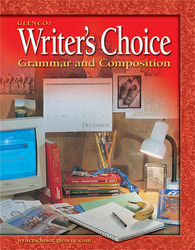
Writer's Choice Grade 7Unit 20: PunctuationOverviewWhen you talk to your friends, sometimes you speak loudly and excitedly. Other times, you ask questions or make requests. You pause between certain words. You may even gesture with your hands. When you write, punctuation can perfectly express excitement or curiosity. Punctuation marks act as signs, or signals, for your audience. An end mark signals the end of a sentence. It requires a pause before beginning the next sentence. Different end marks are used with different types of sentences. The period is used for declarative sentences, which make statements, or imperative sentences, which make requests or give commands. The question mark is used for interrogative sentences, which pose questions. The exclamation point is used for exclamatory sentences in which strong feelings are expressed. A comma represents a pause and separates parts of a sentence to improve understanding. Commas separate items in a series or set off words that interrupt the flow of the sentence. They can set off quotations, introductory prepositional or participial phrases, appositives, and adverb or adjective clauses. Commas are also used before conjunctions that join simple sentences or main clauses. Like commas, semicolons and colons separate parts of a sentence. A semicolon joins compound sentences. And a colon introduces a list of items or separates the hour from the minute in writing the exact time. In writing, quotation marks tell your audience that someone is speaking. Only direct quotes, quotes that tell exactly what a person has said, belong in quotation marks. Italics and underlining are used to identify the title of a book, a newspaper, a television show, or a film. Apostrophes signal possession or point out the missing letters in a contraction. A hyphen divides a word between syllables or joins the parts of compound words. A dash indicates a sudden break or change in thought. Parentheses can be used to set off words that define, or explain, a word in a sentence. Certain words can be abbreviated, or shortened, in writing. Abbreviate titles that come before a person's name, like Mrs. Dixon or Dr. Rossi. Also, abbreviate words that refer to streets and the names of states on envelopes. In charts and tables, always write numbers as figures. In ordinary sentences spell out ordinal numbers, numbers that you can write in one or two words, or any number that begins a sentence. Review Unit 20 (pages 589-617) for more punctuation rules and practice. |  |















